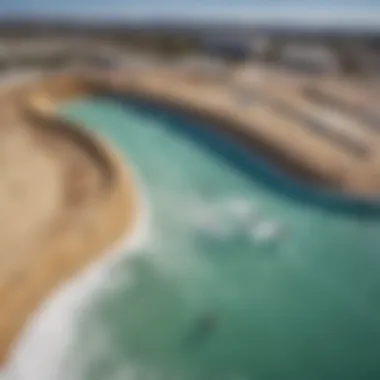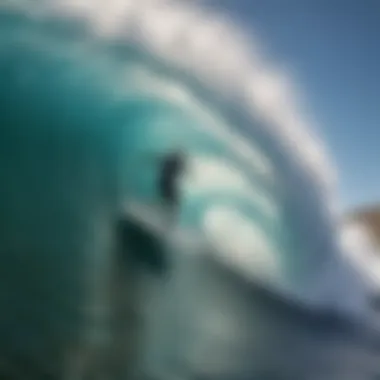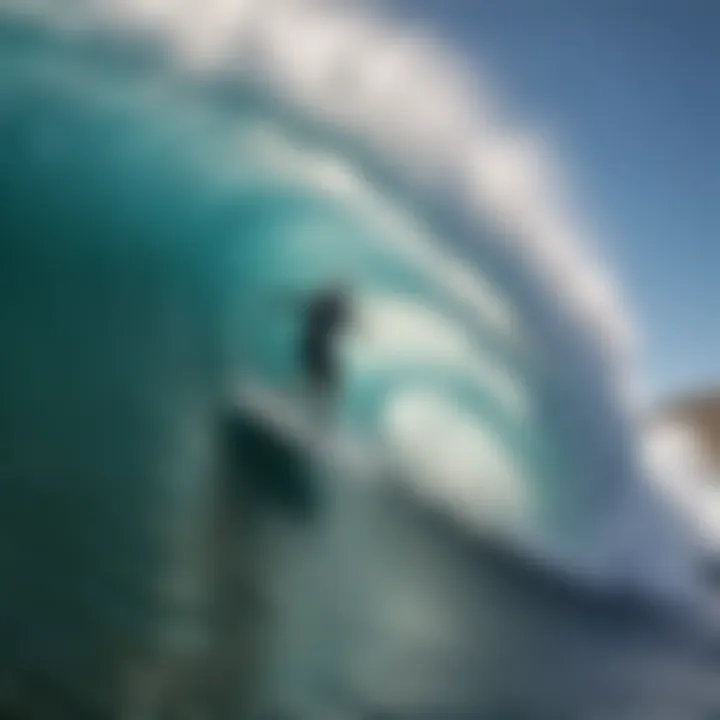Artificial Wave Surfing: California's New Frontier


Intro
The evolution of surfing has often been dictated by the whims of nature. However, as technology steps in, the face of surfing is starting to shift in remarkable ways. In California, the rise of artificial wave surfing marks an intriguing blend of modern innovation and the rich tapestry of traditional surfing culture. Surfers can now ride synthetic waves that mimic the ocean’s dynamic patterns, thus broadening the accessibility of this beloved sport.
Artificial wave pools are not just a passing fad; they are reshaping the surfing landscape. They offer new opportunities for beginners to learn and for seasoned surfers to refine their skills all year round. Moreover, these pools provide a controlled environment where one can avoid the usual unpredictability associated with ocean surfing. The state’s love for watersports provides fertile ground for these facilities to thrive and grow.
As we move forward, this article will explore the techniques and skills required for both novice and advanced surfers while examining essential equipment and gear necessary for an optimal experience in artificial wave surfing. Beyond skill acquisition, let’s also take a close look at the impact of this innovation on the surfing community and experience.
"Artificial wave surfing brings traditional surfing to a broader audience, making it accessible and enjoyable for everyone, regardless of skill level."
This exploration will not only capture the technical aspects of wave pools but also delve into the cultural implications and future prospects for this burgeoning field.
Preamble to Artificial Wave Surfing
Artificial wave surfing has transformed the landscape of watersports in California, merging cutting-edge technology with the age-old tradition of surfing. In recent years, this innovation has gained traction among surfers, instructors, and thrill-seekers alike, redefining not just how surfing is practiced, but who can partake in this exhilarating sport.
With the demand for consistent waves rising, particularly in regions where natural conditions can be unpredictable, artificial wave pools have emerged as a viable solution. Their importance lies in providing a more accessible surfing experience. No more waiting for the perfect swell; surfers can hit the water whenever they please, which is a game changer for enthusiasts.
Defining the Concept
At its core, artificial wave surfing refers to the practice of surfing on waves generated by human-made systems, typically found in wave pools or specialized surf parks. These waves strive to mimic the feel and dynamics of ocean waves yet offer a level of consistency that nature often fails to deliver. Different technologies exist to create waves ranging from gentle rollers for beginners to powerful crashing waves for the seasoned pro.
"Artificial wave technology allows surfers to focus on technique without the variable of ocean conditions. This means more learning and less guessing."
The essence of this concept is about opening up surfing to a wider range of people—kids, adults, and those who live far from the ocean shore can experience the sport in a safe and controlled environment. These man-made waves often incorporate various types of setups, catering to individuals of all skill levels.
Historical Context
The journey of artificial wave surfing isn’t a recent phenomenon, though its current iteration is undoubtedly more advanced. The idea dates back several decades. One of the earliest attempts at creating artificial waves was the Wave House in Durban, South Africa, which featured a moving floor to generate surfers' waves. However, it was only in the late 20th and early 21st centuries that significant advancements occurred.
In California, notable projects like the Wavegarden and Kelly Slater's Surf Ranch have propelled the trend. These state-of-the-art facilities utilize sophisticated engineering to create barreling waves that are nearly indistinguishable from genuine ocean conditions.
As artificial wave technology evolved, so did perceptions within the surfing community. Initially met with skepticism, these man-made waves have gradually been recognized not as a replacement for the ocean, but rather as a complementary experience. The blending of traditional surfing culture with modern advancements has spawned a curious dialogue in the surf community, tackling issues of authenticity, legacy, and future possibilities.
The Technology Behind Artificial Waves
The emergence of artificial wave technology has ushered in a new era for surfers, especially in the context of California's unique surfing culture. As enthusiasts and professionals alike seek reliable and consistent wave conditions, the technology underpinning these developments plays a crucial role. Understanding the mechanics and engineering principles that bring this idea to life is fundamental to grasping its impact on surfers and the broader watersports scene.
Engineering Principles
At the heart of artificial wave creation lies a series of complex engineering principles. These principles encompass hydrodynamics, mechanical engineering, and control systems. The goal is simple but ambitious: to replicate the natural forces that shape ocean waves. One significant aspect is wave simulation, where engineers utilize computational fluid dynamics to predict how waves will behave in various conditions. This scientific approach enables designers to create waves that can be adjusted in size and shape, catering to different skill levels, from beginners to seasoned surfers.
Furthermore, the construction of wave pools often requires a balance between cost and functionality. Engineers must consider the types of materials that can withstand constant exposure to water and salt, all while ensuring energy efficiency. The successful implementation of these engineering principles has allowed for a greater variety of wave types, enhancing the surfing experience.
Types of Wave Pools
The landscape of artificial wave surfing is populated with various types of wave pools, each designed through different technological innovations. These systems are broadly categorized into three generations, each showcasing a distinct advancement over the last.
First-Generation Systems
First-generation wave pools were groundbreaking at their inception. A defining characteristic of these systems is their use of mechanical devices to generate waves. Typically, they employ a large paddle or air compressor to produce waves that can be fun for various skill levels.
The clarity of their operation lies in simplicity: they create repetitive swells that allow surfers to predict wave patterns reasonably well. However, the downside is they often lack the variety found in natural surf conditions. Most notably, one unique feature of these pools is their straightforward design, which appeals to newcomers who appreciate a less intimidating environment. But, these systems may not satisfy advanced surfers seeking more dynamic wave forms.


Second-Generation Systems
As technology progressed, so too did the flair of wave pools. Second-generation systems introduced greater wave variety and control. This generation showcases a mix of mechanical and hydraulic processes to generate waves that vary in size and shape throughout a session.
The enhanced characteristic of these systems is the ability to create more intricate wave forms that resemble real ocean waves closely. What's interesting is, they provide a more engaging experience for all surfers due to this variety. However, there's a drawback as well: the complexity of operation tends to mean higher operational costs, making them less accessible for some users.
Third-Generation Systems
Taking things a step further, third-generation systems are where the magic really begins to unfold. They utilize advanced technology, including software-driven controls that dynamically adjust wave characteristics in real-time based on user feedback and environmental conditions. This kind of responsive design enables these pools to offer the most realistic surfing experience available today.
The standout feature here is the impressive variety of wave types; everything from gentle rollers to tubular waves can be produced in quick succession. This adaptability makes these systems beneficial for both training and recreational use, ensuring that all surfers walk away satisfied. Nevertheless, one must consider that this brilliance in technology comes at an elevated price point, which could hinder accessibility for some aspiring surfers.
"The evolution of wave pool technology not only broadens the surfing landscape but also poses both opportunities and challenges for the community."
In sum, the technology behind artificial waves represents a synthesis of innovation, engineering, and cultural change. Understanding the different generations of wave pools is crucial for appreciating the full spectrum of what artificial wave surfing has to offer, from a controlled training environment to the excitement of hitting perfect waves, all year-round.
Prominent Locations in California
Artificial wave surfing has taken California by storm, creating unique venues that blend cutting-edge technology with the thrill of surfing. Understanding these prominent locations is crucial, as they stand as the epicenters of innovation and accessibility within the surfing community. Each venue not only offers consistent wave conditions but also fosters a communal atmosphere that attracts surfers of all skill levels. Moreover, these locations are reshaping perceptions about what surfing can be, making it more inclusive and open to a wider audience.
The Wave in Orange County
Nestled in the heart of Orange County, The Wave has quickly emerged as a hotspot for wave enthusiasts. This facility is renowned for its state-of-the-art technology that delivers waves tailored to different skill levels – from beginners to seasoned pros.
- Wave Variety: Unlike the ocean, where the waves can be unpredictable, The Wave offers a range of wave types that surfers can choose from. Whether you fancy a mellow roller for practice or a steep, challenging wall for your tricks, there's something for everyone.
- Community Engagement: The Wave is not just about surfing; it's also about building a sense of community. It often hosts local competitions, events, and surf camps, making it a fantastic opportunity for surf instructors and coaches to connect with newcomers, catering to the adventurous spirit of those who thrive in the waters.
"The Wave is like a modern surf school – an all-access pass to hone your skills without the pressure of ocean conditions."
Here, one can practice consistently without facing the waves of a natural beach. This guarantees that practicing surfers see continuous improvement, while also nurturing a camaraderie you might not find elsewhere.
Surf Ranch in Lemoore
Another pivotal location is the Surf Ranch in Lemoore, which boasts one of the most sophisticated artificial wave systems in the world, created by the legendary surfer Kelly Slater. The Surf Ranch not only serves as a training ground but is also a stunning venue for competitions.
- Technological Mastery: The technology employed here allows for larger, more powerful waves, mimicking ocean swells more closely than other facilities. The waves can be adjusted in size and frequency, providing a profoundly customizable experience.
- Global Attention: Known for hosting elite competitions like the World Surf League events, Surf Ranch has put California on the map as a focal point for high-performance surfing. Surfers flock from around the globe to experience these world-class waves.
This venue elevates not just the surfer’s performance but also adds to the overall aesthetics and experience, blending nature and technology seamlessly.
Other Notable Wave Pools
In addition to The Wave and Surf Ranch, California is home to several other notable wave pools that are making waves in the surfing scene.
- NLand Surf Park (Austin might have the spotlight in Texas, but California’s wave parks are equally impressive): Known for its impressive wave technology, this park is set in a vibrant, coastal-like setting, attracting both tourists and locals.
- Wavegarden in various locations: This innovative company provides customizable and accessible surfing experiences. Each Wavegarden site is distinct, yet they all share a commitment to producing high-quality artificial waves that bridge the gap between recreation and professional training.
The essence of these other wave pools lies not just in their technical feats, but also in their potential for fostering new generations of surfers. They offer profound opportunities for instructors to guide novices while providing consistent conditions for pros to refine their craft.
Each of these venues tells a story about the transformation of surfing culture, breaking down barriers and promoting inclusivity in a traditionally exclusive sport. As technology and community intertwine within these prominent locations, they pave the way for a surfing revolution that embraces the future.
Cultural Impact on Surfing
Artificial wave surfing isn’t just about generating waves—it’s a transformative force that shapes the culture of surfing itself. From how surfers perceive their craft to who gets to ride the waves, artificial wave technology introduces fresh narratives and changes that ripple through the community. The rise of wave pools has modernized the surfing landscape, creating a platform that caters to a broader audience. This section delves into the changing perceptions of surfing and how wave pools contribute to inclusivity and accessibility.
Changing Perceptions of Surfing


Historically, surfing has been tied closely to specific coastlines and natural phenomena. The culture often celebrated exclusivity, rooted in geographical advantage. However, the advent of artificial wave surfing challenges this notion. With wave pools sprouting up in urban areas, surfing now feels less like a privilege reserved for a select few and more like a universal sport.
For instance, young surfers from the Midwest can now catch waves without traveling all the way to California. This leveling of the playing field allows for new friendships and connections among surfers from different backgrounds. Each visit to a wave pool can thus be seen as a mini-community event, where folks share tips, tricks, and stories, enhancing the sense of brotherhood and sisterhood within the sport.
Furthermore, as more people gain access to surf culture, we see a shift in what it means to be a surfer. The focus increasingly moves toward skill development and a communal enjoyment of the water rather than merely riding the waves at iconic locations.
"Surfing has always been about connecting to the ocean, but with artificial waves, it’s as if we’ve connected to each other in ways we never expected."
— A passionate surfer from a wave pool event.
Inclusivity and Accessibility
Artificial wave surfing makes significant strides in promoting inclusivity in a sport traditionally deemed exclusive. Wave pools, by design, are welcoming places for people of all ages, skill levels, and backgrounds. A family of beginners can comfortably enjoy a session together, novice surfers can find their footing, while accomplished surfers can perfect their techniques without the intimidation that crowded ocean waves often bring.
- Benefits of Inclusivity:
- Accessibility Features:
- Diverse Communities: Experience shows that these venues attract a wide array of users—young kids, families, and seasoned surfers alike.
- Skill Development: Beginning surfers can practice without the unpredictability that ocean waves present, gaining confidence and competence.
- Cultural Exchange: Different surfing styles and experiences converge, broadening the cultural fabric of the surfing community.
- Adapted Facilities: Many wave pools are designed to accommodate individuals with disabilities.
- Learning Programs: Specialized courses encourage participation from underrepresented groups, including women and youth from urban areas.
In essence, artificial wave surfing is not merely about enjoying artificial waves. It’s a cultural shift that redefines who gets to enjoy this sport and how they can engage with it. As artificial wave pools gain popularity, they foster communities, skills, and a new wave of surf culture that embraces everyone.
Benefits for Surfers
Artificial wave surfing has brought a wave of change to the surfing communities in California and beyond. Unlike the unpredictable nature of ocean waves, these engineered surf environments offer a suite of benefits that cater to all surfers, whether they are seasoned pros or fresh faces paddling out for the first time. Understanding these perks is critical for noting how artificial waves reshape the surfing experience in profound ways.
Consistent Wave Conditions
One of the most significant draws of artificial wave pools is their ability to provide consistent wave conditions. Unlike the ocean, which is influenced by myriad factors—from tides to storms—artificial waves can be generated on demand. This predictability allows surfers to hone their skills without having to gamble on weather patterns. For instance, at the Surf Ranch in Lemoore, wave height and frequency can be controlled meticulously, enabling surfers to practice the same maneuver repeatedly until it becomes second nature. This controlled environment can lead to faster improvement, as riders can focus solely on technique without the added stress of unpredictable conditions.
"It’s like practicing in a gym for surfing. You know what to expect each time you hit the water."
— Local Surf Coach
Enhanced Training Opportunities
Artificial wave pools aren’t just playgrounds; they serve as valuable training grounds. For professional surfers preparing for competitions or amateurs aiming to level up their skills, these wave pools present a unique opportunity. The waves can be adjusted to match different skill levels, meaning a beginner can experience smaller, gentler waves, while an expert can challenge themselves with larger, more powerful surf. Furthermore, without the distractions of crowds that often swarm popular ocean surf spots, surfers can focus more on their rides. Many surfing schools have even started to utilize these facilities for lessons, cementing them as essential hubs in the surfing community.
Year-Round Surfing Experience
Lastly, one of the most appealing aspects of artificial wave surfing is the availability of a year-round surfing experience. In a place like California, where surfing is often seen as a seasonal activity, the advent of artificial wave pools breaks down those barriers. Surfers can now catch a wave regardless of the time of year. Whether it's a crisp winter morning or a sweltering summer afternoon, the chance to surf is just a reservation away. Facilities often have temperature-controlled waters and comfortable amenities, making them attractive places to spend a day out, regardless of the season.
In summary, the benefits for surfers using artificial wave technology are indeed vast. Whether it's the reliability of wave conditions, enhanced training opportunities, or the ability to surf year-round, these modern innovations streamline the surfing experience, making it more accessible and enjoyable for everyone.
Challenges and Criticisms
The rise of artificial wave surfing has not come without its share of challenges and criticisms. This section dives into significant concerns that have emerged in the wake of this technological advancement, focusing on environmental aspects and the authenticity of the surfing experience.
Environmental Concerns
As with many innovations that touch upon nature, artificial wave surfing raises eyebrows regarding its environmental footprint. Wave pools, while a marvel of engineering, often require substantial resources to build and maintain. Here are the primary environmental considerations:
- Water Use: Wave pools need a steady supply of water. In regions like California, where the water supply can be precarious, the demand for fresh water from these facilities can lead to tension with local communities and ecosystems.
- Energy Consumption: The operational machinery that creates wave conditions can be energy-intensive. There’s an ongoing discussion about whether the energy consumed, often derived from carbon-emitting sources, offsets the benefits of democratizing surfing.
- Impact on Local Flora and Fauna: Large pools may alter local habitats. The construction and operation might disturb wildlife or plant life in the area, sometimes prompting environmentalists to raise flags regarding biodiversity.
For many environmental activists, the essence of surfing is closely tied to nature—riding waves shaped by winds and tides, not machines. Thus, the environmental repercussions of artificial wave setups can provoke heated debates amongst surfing purists and advocates of technology.
"To truly connect with the ocean, some surfers argue, one must engage with its natural rhythms rather than synthetic replicas."


Authenticity of the Experience
The authenticity debate surrounding artificial wave surfing is another critical dimension. Many surfers cherish the raw experience that comes with catching waves in open water, where unpredictability reigns. The following considerations contribute to the discussion:
- The True Essence of Surfing: Critics argue that surfing isn't just about riding waves but about connecting with the ocean’s rhythms. Wave pools may mimic the wave experience, but for some, they lack the emotional and spiritual essence that comes with surfing in the ocean.
- Aesthetic Appeal: There’s something captivating about the view of ocean waves, especially when they are framed by sunlight or storm clouds. Wave pools, despite aesthetic efforts, can feel sterile and manufactured.
- Cultural Significance: Surfing carries with it a rich history and culture. The artificial nature of wave pools can sometimes bypass these traditions, leaving some enthusiasts feeling disconnected from the surf community at large. For them, it’s not just about the ride—it’s an entire lifestyle rooted in surfing's heritage.
In summary, while artificial wave surfing opens doors to new experiences and accessibility, these challenges and criticisms spotlight the complex relationship between modern technology and traditional surfing. They encourage ongoing dialogue within the surfing community about what it means to surf in today's world.
Future Prospects of Artificial Wave Surfing
Artificial wave surfing in California is not just a trend; it's the dawn of a new era in watersports that could drastically reshape the surfing landscape. As the balance between nature and innovation grows ever more crucial, the future prospects of artificial waves hinge on a few pivotal elements. They highlight how this technology might evolve while recognizing the potential benefits, challenges, and considerations that lie ahead.
Technological Advancements
The journey of artificial wave technology continues to evolve, showing remarkable advancements that can alter the surfing experience for the better. One significant avenue is the development of more sophisticated wave generation systems, which aim to produce waves that mimic the unpredictable nature of ocean classics.
- Hydrodynamic Modeling: Cutting-edge computational techniques help engineers predict how waves will behave in various conditions, leading to more engaging surfing experiences.
- Energy Efficiency: New methods are being explored to power these wave pools more sustainably, relying on renewable sources, which could minimize their ecological footprint.
- User Customization: Future wave pool designs may allow surfers to customize wave shapes and sizes tailored to their skill levels, creating a truly personalized surfing experience.
These advancements don't merely enhance enjoyment but also showcase the merging of technology with sports, potentially broadening accessibility to those previously unable to surf.
Potential Locations for New Developments
As the interest in artificial wave surfing grows, identifying suitable locations for new developments becomes paramount. Various factors come into play when considering where to establish these cutting-edge wave pools. Locations must not only have adequate space but also a supportive community, infrastructure, and the right environmental considerations. Here are some potential locations that could be ripe for development:
- Urban Centers: Places like Los Angeles and San Diego have vast populations craving access to surf experiences, despite limitations posed by natural waves.
- Suburban Areas: Communities such as the San Francisco Bay Area could benefit from local developments that allow families to easily access surfing opportunities without traveling to the coast.
- Tourist Destinations: Locations like Lake Tahoe or areas in the Central Valley could see artificial wave pools as attractions, combining vacation fun with surfing.
Bringing artificial wave pools to these regions could create vibrant hubs for surfing enthusiasts, encouraging local economies while fostering a new wave of surfers who might otherwise never step foot on a board.
"Artificial wave surfing is not just pushing top-tier athletes to new heights, but it's also lowering the barriers for newcomers to embrace a sport rich in tradition and community."
The future of artificial wave surfing in California looks promising, with the combination of technological advancements and strategic location development paving the way for a transformed surfing culture that achieves a deeper connection to both technology and nature. If handled wisely, this endeavor could ensure that wave riding remains a beloved activity, accessible and enjoyable for generations to come.
Epilogue and Reflections
As we wrap up our exploration into artificial wave surfing in California, we're reminded of the intricate tapestry of technology woven into the age-old culture of surfing. This convergence has not merely provided new venues for surfers but has also triggered a paradigm shift in how people engage with the ocean and the sport itself. The question of accessibility stands out, carving pathways for aspiring surfers who might not typically be able to navigate the often unpredictable conditions of natural waves.
In this narrative, it’s paramount to recognize the many layers of impact artificial waves have imparted on the surfing community and its culture. Here are a few key points to summarize the profound influence:
- Accessibility: By offering consistent wave conditions, these wave pools enable a broader segment of individuals to try their hand at surfing, regardless of their geographical location or skill level.
- Cultural Shifts: The very essence of traditional surfing, with its nuances of respect for nature and local spots, faces new challenges and dialogues amid these technological advancements.
- Environmental Considerations: The conversation has broadened to include the sustainability of such technology, prompting stakeholders to think critically about resource use and impact on local ecosystems.
"Artificial wave technology is reshaping not just how we surf, but also who gets to surf."
As the lines between natural and artificial continue to blur, we also have to contemplate the historical context and future implications entwined with these developments. The advancements could very well chart new waters for competitive surfing, with potential competitions being held in controlled environments that present equal challenges for all competitors.
That said, the joy of riding a wave — regardless of its origin — is a sentiment that echoes throughout the community. Surfers will ever treasure the thrill of being on a board, skimming just above the surface, whether in ocean swells or in a meticulously engineered pool.
Summarizing the Impact
The momentum behind artificial wave surfing in California has evolved into a significant cultural movement. Not just a passing fad, these innovations address both practical needs and long-standing desires among surfers. Key impacts include:
- Community Building: These venues serve as hubs for interaction, allowing surfers to connect in new ways.
- Evolution of Skills: For beginners to seasoned pros, predictable wave patterns facilitate the honing of skills in an environment free from the uncertainties that characterize natural surfing.
- Competition and Events: The growth of organzied competitive events in artificial spaces introduces a unique dynamic, likely reshaping competitive formats for many years to come.
Personal Perspectives on the Evolution of Surfing
Reflecting on the evolution of surfing, it’s fascinating to witness how technology has gently stirred the waters of tradition. Many might contend that the rise of artificial surfing takes away from the spirit of catching waves, yet others find it invigorating.
During interviews with various surfers, a common theme emerges:
- Adaptation: "Surfers are a resilient bunch, always adapting to waves, weather, and now, technology. Artificial waves are just the next step in that journey."
- Experience: Some express nostalgia for the chaos of the beach, while others embrace the slightly less adrenaline-pumping environments of wave pools as a worthy alternative.
- Inclusivity: There’s a consensus that these advancements open the doors wide for anyone curious about surfing, democratizing what was once an elite sport.
In the grand scheme of things, the synergy of tradition and innovation offers surfers of all walks of life new opportunities to share their passion, regardless of age, experience, or background. It’s a testament to the enduring allure of riding the waves, whatever form they may take.







